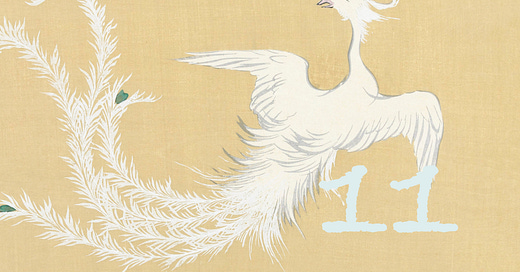I want the word death. I want the word God. I also want peonies and the color blue. The words are growing in the field ... like flowers, and I pick the ones I like. ~Mary Ruefle
Creativity Prompt #11: The Art of Erasure | 30-Day Creativity Challenge
Bird from Momoyogusa–Flowers of a Hundred Generations (1909) by Kamisaka Sekka
Already during this creativity challenge, we’ve talked about the act of defining by negating, the process of understanding what something is by staring deeply into what it is not. Perhaps, in a certain way, the art of erasure falls under this umbrella, in the sense that it involves discovering something meaningful in a piece of text by carving most of it away.
Perhaps you have already heard of or even played around with erasure, which is also called erasure poetry, or blackout poetry. No matter what we call it, what we do when we practice erasure is take a text — and the text can be anything from an existing story or essay to a newspaper article to an Ikea furniture assembly guide to a Shakespeare play—and erase (or black out or cross out) words (usually most of the words), until some hidden meaning emerges from what remains.
Sometimes, and very notably in the height of the Trump and #MeToo era, erasure poets erased specific texts specifically as an act of subversion and resistance. For example, you can read erasures of so-called #MeToo apologies here.
But there’s another way to erase—a dreamier, less purposeful way. One driven less by a conscious destination and more by the subconscious dreamscape. I’m referring here to a method used by the acclaimed poet Mary Ruefle, who doesn’t even read the source texts she sets out to erase. Instead she lets the words float/hover 1/8th inch off the paper and then “picks them like flowers.”
Ruefle described her process to Hyperallergic in 2021:
Still, Ruefle’s daily erasure practice — she’s completed more than 110 books — has a strong visual art slant. She uses markers, correctional fluid, paint, tape, and even cuts text from the page with scissors to erase existing words and phrases. Texts, photos, and drawings from other publications make their way into these pages, as well as pressed flowers, handwritten notes, grocery lists, fingerprint samples, tangles of string, and other objects. Ruefle’s textured, altered pages collectively form a nonlinear but sequential experience-object that playfully questions notions of authorship — whose work is this now? — while bridging, collapsing, and confounding tidy boundaries between image and text, collage, and literature.
“I like to take boring, obscure texts that nobody reads and that nobody would want to read,” she noted. Ruefle favors books that are, in her words, “very sentimental and by today’s standards totally politically incorrect.” Scouring thrift stores, used bookshops, and estate sales, Ruefle selects a book by scrutinizing its text, considering its words as raw material. “I want nouns,” she said. “I want a balance of the abstract and the concrete. I want the word death. I want the word God. I also want peonies and the color blue.”
Ruefle doesn’t read the books before erasing them; her process is intuitive and improvisatory. “I describe it like this: the two pages are a field,” Ruefle explained. “The words are growing in the field, and they hover above the page. They’re like flowers, and I pick the ones I like. My eye is roaming all over, trying to make connections.” The resulting texts are lyrical and melancholic, but sharply funny, too. In a spread from The Story of Ida (originally by Francesca Alexander and published in 1883), Ruefle has glued half of a signed check for one cent, while the text on the facing page wryly reads, “a poet, / that first happy winter / I was / beginning to earn money.”
Although I find Ruefle’s work and her process wildly inspiring, I must emphasize that erasure can also be exceedingly simple. At the end of the day, you can erase absolutely anything, from a piece of junk mail to a receipt to a book, and whether you lean to the artistic or the simple version of this process, it can be an intensely inspiring practice simply by eliminating the tyranny of the blank page. With erasure, rather than face down nothingness, you get to play in a rich field of language.
Indeed, how you erase is up to you and you can try a variety of methods. Here are some detailed instructions to get you started and—including some tips on avoiding common pitfalls.





